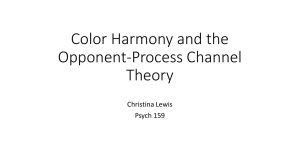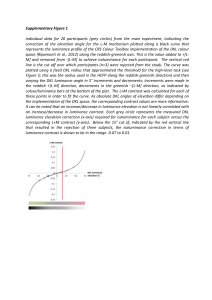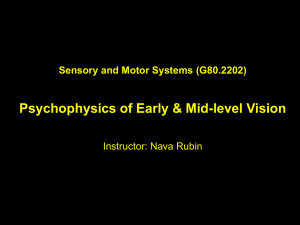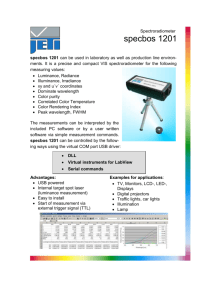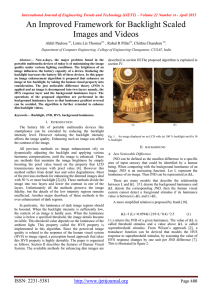Image Enhancement Using Adaptive Filtering —
advertisement
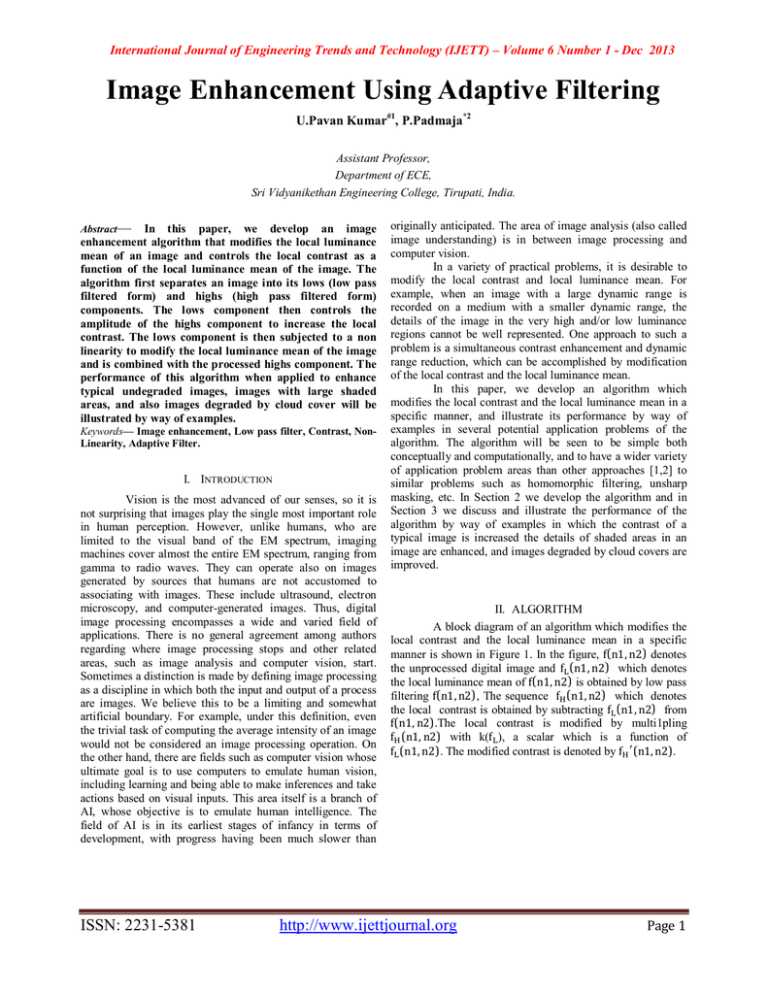
International Journal of Engineering Trends and Technology (IJETT) – Volume 6 Number 1 - Dec 2013 Image Enhancement Using Adaptive Filtering U.Pavan Kumar#1, P.Padmaja*2 Assistant Professor, Department of ECE, Sri Vidyanikethan Engineering College, Tirupati, India. Abstract— In this paper, we develop an image enhancement algorithm that modifies the local luminance mean of an image and controls the local contrast as a function of the local luminance mean of the image. The algorithm first separates an image into its lows (low pass filtered form) and highs (high pass filtered form) components. The lows component then controls the amplitude of the highs component to increase the local contrast. The lows component is then subjected to a non linearity to modify the local luminance mean of the image and is combined with the processed highs component. The performance of this algorithm when applied to enhance typical undegraded images, images with large shaded areas, and also images degraded by cloud cover will be illustrated by way of examples. Keywords— Image enhancement, Low pass filter, Contrast, NonLinearity, Adaptive Filter. I. INTRODUCTION Vision is the most advanced of our senses, so it is not surprising that images play the single most important role in human perception. However, unlike humans, who are limited to the visual band of the EM spectrum, imaging machines cover almost the entire EM spectrum, ranging from gamma to radio waves. They can operate also on images generated by sources that humans are not accustomed to associating with images. These include ultrasound, electron microscopy, and computer-generated images. Thus, digital image processing encompasses a wide and varied field of applications. There is no general agreement among authors regarding where image processing stops and other related areas, such as image analysis and computer vision, start. Sometimes a distinction is made by defining image processing as a discipline in which both the input and output of a process are images. We believe this to be a limiting and somewhat artificial boundary. For example, under this definition, even the trivial task of computing the average intensity of an image would not be considered an image processing operation. On the other hand, there are fields such as computer vision whose ultimate goal is to use computers to emulate human vision, including learning and being able to make inferences and take actions based on visual inputs. This area itself is a branch of AI, whose objective is to emulate human intelligence. The field of AI is in its earliest stages of infancy in terms of development, with progress having been much slower than ISSN: 2231-5381 originally anticipated. The area of image analysis (also called image understanding) is in between image processing and computer vision. In a variety of practical problems, it is desirable to modify the local contrast and local luminance mean. For example, when an image with a large dynamic range is recorded on a medium with a smaller dynamic range, the details of the image in the very high and/or low luminance regions cannot be well represented. One approach to such a problem is a simultaneous contrast enhancement and dynamic range reduction, which can be accomplished by modification of the local contrast and the local luminance mean. In this paper, we develop an algorithm which modifies the local contrast and the local luminance mean in a specific manner, and illustrate its performance by way of examples in several potential application problems of the algorithm. The algorithm will be seen to be simple both conceptually and computationally, and to have a wider variety of application problem areas than other approaches [1,2] to similar problems such as homomorphic filtering, unsharp masking, etc. In Section 2 we develop the algorithm and in Section 3 we discuss and illustrate the performance of the algorithm by way of examples in which the contrast of a typical image is increased the details of shaded areas in an image are enhanced, and images degraded by cloud covers are improved. II. ALGORITHM A block diagram of an algorithm which modifies the local contrast and the local luminance mean in a specific manner is shown in Figure 1. In the figure, f(n1, n2) denotes the unprocessed digital image and f (n1, n2) which denotes the local luminance mean of f(n1, n2) is obtained by low pass filtering f(n1, n2), The sequence f (n1, n2) which denotes the local contrast is obtained by subtracting f (n1, n2) from f(n1, n2).The local contrast is modified by multi1pling f (n1, n2) with k(f ), a scalar which is a function of f (n1, n2). The modified contrast is denoted by f (n1, n2). http://www.ijettjournal.org Page 1 International Journal of Engineering Trends and Technology (IJETT) – Volume 6 Number 1 - Dec 2013 The algorithm modifies the local contrast as a function of the local luminance mean, and also modifies the local luminance mean. This feature of the algorithm is useful in a variety of application problem. For typical images, it is often desirable for visual purposes to increase the local contrast. One approach to achieve such an objective is to choose k(f ) to be a constant greater than 1 independent of local luminance mean f and reduce the dynamic range of f(n , n ), through the non-linearity to account for dynamic range increase which results from the contrast increase. The low pass filtering operation used is a simple local averaging given by Fig. 1 Block Diagram Of Adaptive Filter. The specific functional form of k(f ) depends on the particular application under consideration, and k(f )>1 represents the local contrast increase while k(f )<1 represents local contrast decrease. The local luminance mean is modified by a point non-linearity and the modified local luminance mean is denoted by f (n , n ) . The specific non-linearity chosen depends on the particular application under consideration, and in most application problems the non-linearity is chosen so that the overall dynamic range of the resulting image is approximately the same as the dynamic range of the recording medium. The modified local contrast and local luminance mean are then combined to obtain g(n , n ), the processed image. ( , )= (2 1 + 1)(2 + 1) ( , 1) It is clear that the processed image gives a sharper appearance than the original unprocessed image. Another potential application area of the algorithm is the enhancement of an image which has large areas of shadows. In shaded regions of an image, the local contrast is typically suppressed relative to other regions. One approach to bring out the details in shaded region is to increase the local contrast in shaded regions relative to other regions. Another potential application area of the algorithm in Figure 1 is the enhancement of an image which has large areas of shadows. In shaded regions of an image, the local contrast is typically suppressed relative to other regions. The performance of the algorithm presented in this paper is not very sensitive to specific choices of k(f ), the nonlinearity, and the low pass filtering operation. Specifically, when k(f ), the non linearity and the low pass filtering operation are chosen so that they preserve the general characteristics but differ in details from the ones used in this paper, the processed images are very similar to the results illustrated in this paper. One advantage of this algorithm relative to other techniques used for similar purposes such as homomorphic filtering, unsharp masking, histogram equalization etc., is that the algorithm is both conceptually and computationally as simple and at the same time is adaptive to the local characteristics of an image, namely the local luminance mean. This feature of the algorithm is responsible for its wide range of potential application areas. In addition to the specific application areas discussed in this paper, for example, the algorithm is potentially applicable to enhancement of image degraded by varying amounts of smoke cover, haze, fog, etc. in different regions of an image, and the local luminance mean equalization for image segmentation. Fig. 2 Flow Chart Of Adaptive Filter. ISSN: 2231-5381 http://www.ijettjournal.org Page 2 International Journal of Engineering Trends and Technology (IJETT) – Volume 6 Number 1 - Dec 2013 III. RESULTS Original Image Scalar Low Pass Filtered Image Modified Contrast Adaptive Filtering Image Contrast Stretch ISSN: 2231-5381 http://www.ijettjournal.org Page 3 International Journal of Engineering Trends and Technology (IJETT) – Volume 6 Number 1 - Dec 2013 IV. CONCLUSION Image enhancement of MRI knee image through these methods will help the physiotherapists to select from the stream of enhanced image data of the single image in different forms. REFERENCES [1] Rafael C. Gonzalez and Richard E. Woods. Digital Image Processing. Addison Wesley Publishing Company, 1992, chapter 4. [2] W.K. Pratt, Digital Image Processing,(John Wiley and Sons, 1978). [3] H.C. Andrews, B.R. Hunt,Digital Image Restoration, (Prentice— Hall,Englewood Cliffs, NJ 1977). [4] Tarek A. Mahmoud, Stephen Marshall, “Medical Image Enhancement Using Threshold Decomposition Driven Adaptive Morphological Filter”, 16th European Signal Processing Conference (EUSIPCO 2008), R.Sharmila, R. Uma, “A New Approach To Image Contrast Enhancement using Weighted Threshold Histogram Equalization with Improved Switching Median Filter”, International Journal Of Advanced Engineering Sciences and Technologies Vol No. 7, No. 2, 2011, P. 206 – 211. [5] H.D. Cheng, Huijuan Xu, “A novel fuzzy logic approach to contrast enhancement”, Pattern Recognition, Vol. 33, 2000, P.809-819. [6] Gerard J. Tortora, B.H.D., Principles of Anatomy and Physiology, 11th Edition. April 2005: John Wiley & Sons Inc. [7] Zhou Wang, Alan.C. Bovik, “ A Universal Quality Index”, IEEE Signal Processing Letters,Vol. 20, 2002,P. 1-4. [8] Lee, J.M. and F.H. Fu, The meniscus: Basic science and clinical applications. Operative Techniques in Orthopaedics, 2000. 10(3): p. 162-168. [9] Ashton, E., Method and system for automatic identification and quantification of abnormal anatomical structures in medical images, U.P.a.T. Office, Editor. 2004, VirtualScopics, LLC: USA. [10] Oatridge, A., et al., Magnetic resonance: Magic angle imaging of the Achilles tendon. Lancet, 2001. 358(9293): p. 1610-1611. ISSN: 2231-5381 http://www.ijettjournal.org Page 4
